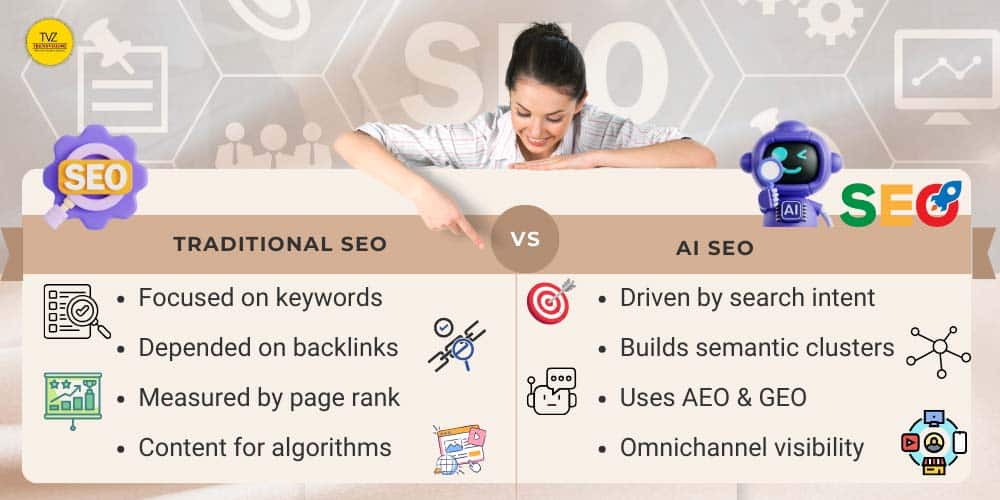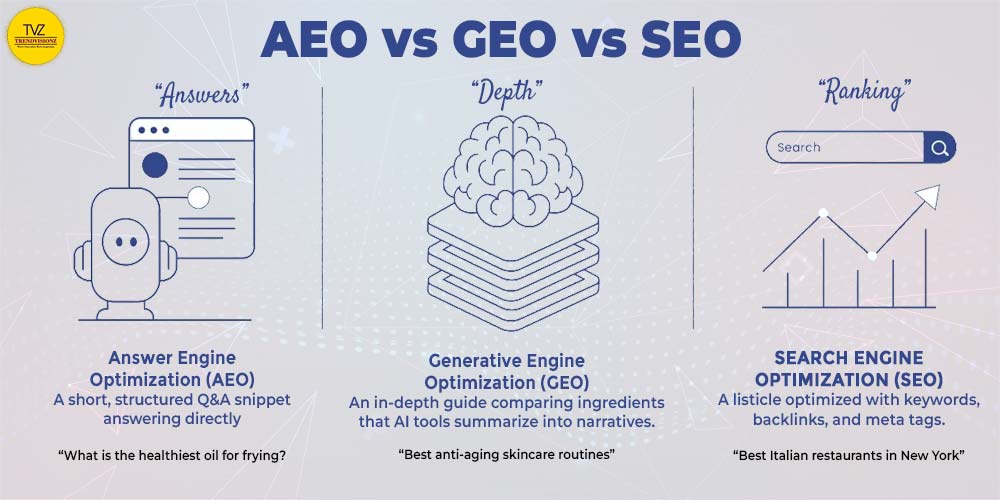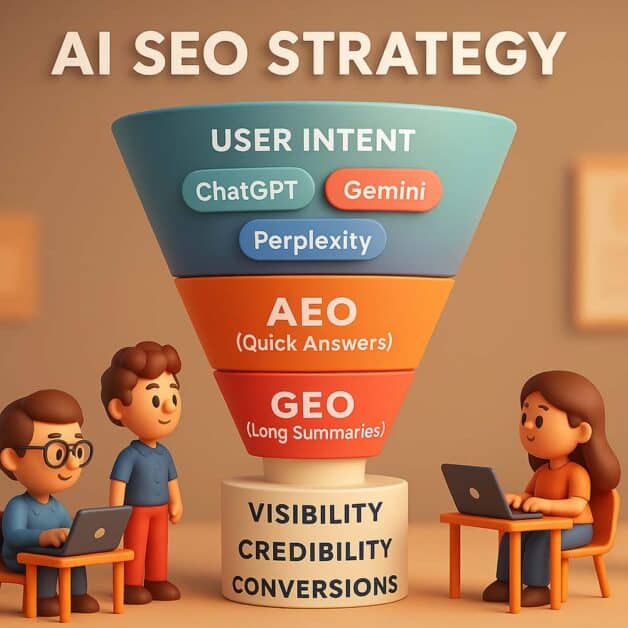Has AI officially killed SEO? In a recent video, Palki Sharma highlighted that nearly 80% of top websites are losing traffic. This reflects what many businesses are facing today. Research shows that with AI summaries and zero-click searches rising, traditional visibility is under pressure. But does this mean SEO is dead? Not at all. SEO in the age of AI is evolving into something smarter and more adaptive.

At TrendVisionz, the digital arm of Nuteq Entertainment with three decades of media expertise, we have witnessed this shift up close. By working with high-ticket clients across industries, we understand what truly drives visibility in today’s search landscape. We see SEO and AI converging to shape a new era of discoverability.
This research oriented article explores how Answer Engine Optimization (AEO) and Generative Engine Optimization (GEO) are reshaping the fundamentals of search visibility. User behaviour is changing fast. As an experienced agency, we share the practical strategies, to futureproof visibility in the digital marketing in AI era. Brands must think beyond a single platform
Get ready to grow with an omnichannel approach in an AI-driven world.
Also Read:
- How to Use Internal Site Search to Discover Content Ideas
- Content Readability & SEO: How Optimization Tools Help
SEO in the Age of AI: What Changed?
AI-Powered platforms we all prefer using like Google AI Overviews, ChatGPT, Gemini, and Perplexity now provide users with instant summaries and direct answers. For most businesses who want growth, this evolution demands a new approach to achieving visibility.
From Keywords to Semantic Search Optimization
Search has shifted beyond exact keywords. Today, AI-powered engines interpret context, intent, and topical depth. Success depends on building semantic authority with structured content that answers real questions, not just targeting individual terms.
Why keywords alone no longer work?
Google reports that nearly 15% of daily searches are brand new. AI interprets intent and context, not just exact matches.
- Focus on context, not single words
- Build topical authority with clusters
- Use LSI keywords for semantic depth
Key takeaway: Success depends on answering questions naturally and covering topics in depth.

How are users changing their search habits?
According to a BrightEdge study, 68 percent of online journeys today begin with AI-powered search engines or digital assistants.
- Organic traffic is shrinking: Similarweb data shows AI Overviews can reduce website visits by as much as 30 percent.
- Zero-click searches 1are growing: SEMrush reports that 57 percent of queries now end without any clicks.
- User intent is paramount: Audiences increasingly expect quick, precise, and relevant answers.
Zero-click searches are rising: SEMrush notes 57% of queries end without a click.
A majority of Google searches—58.5% in the U.S. and 59.7% in the EU—result in zero clicks- Search Engine Land

This shows how AI summaries and instant answers are reducing the need to visit websites at all.
Key takeaway: Visibility today is about aligning with AI summaries and intent, not just ranking on page one.
AEO and GEO: The New Playbook
Answer Engine Optimization (AEO) and Generative Engine Optimization (GEO) are transforming how brands achieve visibility. In today’s AI-driven search landscape, ranking on Google alone is no longer sufficient. Businesses must design content that platforms like ChatGPT, Gemini, and Perplexity can surface directly in summaries and answers.
What is Answer Engine Optimization (AEO)?
Answer Engine Optimization (AEO) is the process of shaping content so AI search engines select it as the best answer, such as recipes or nutrition facts from food blogs.
Example: A food blog that publishes a clear Q&A like “What is the healthiest oil for frying?” and adds schema markup can be cited by Google AI Overviews or ChatGPT when users search cooking tips.
How does AEO help brands get discovered?
AEO ensures your content becomes the “default answer” that AI-powered search engines and voice assistants use. It works best when content is simple, structured, and written in a conversational tone.
- Use direct Q&A formats to answer common queries
- Add schema markup for FAQs, how-to guides, and lists
- Craft concise, authoritative responses tailored for voice queries.
- Target natural, conversational long-tail questions that users ask verbally or type.
Example: A healthcare website answering “What are the early signs of diabetes?” in a structured FAQ increases its chances of being cited by Perplexity or Google AI Overviews. This type of AI SEO improves trust and visibility in health queries.
Key takeaway: AEO is about precision. It makes your content discoverable when users ask AI search engines for direct answers.

How Does Generative Engine Optimization (GEO) Work?
Generative Engine Optimization (GEO) helps brands appear in AI-generated summaries. GEO relies on detailed, trustworthy content. AI platforms reward depth, structure, and authority by pulling brands into longer, contextual narratives.
Example: A skincare brand that publishes an in-depth guide comparing ingredients like retinol, peptides, and hyaluronic acid. Their consistent content covers benefits, risks, and expert opinions. This website for the brand is more likely to be featured in Gemini’s generative summaries for “best anti-aging skincare routines.”
This skincare example shows how GEO rewards depth. The point of discussion is why has this approach become essential for businesses across different industries today?
| Aspect | AEO (Answer Engine Optimization) | GEO (Generative Engine Optimization) |
| Focus | Direct answers to user queries | In-depth inclusion in AI-generated summaries |
| Best suited for | FAQs, definitions, how-to guides | Comprehensive guides, comparisons, expert insights |
| Examples | “What is the healthiest oil for frying?” | “Best anti-aging skincare routines: ingredients compared” |
| Platforms | Google AI Overviews, ChatGPT voice answers | Gemini, Perplexity, ChatGPT narrative summaries |
A look at the table will helps readers quickly compare AEO and GEO. Awareness on when to use each. The comparitive table simplifies complex SEO concepts, making AI search strategies clearer and easier to apply for SEO Professionals.
Upto now the traditional SEO, focused mainly on climbing rankings by targeting keywords and building backlinks. AEO is about becoming the direct answer users receive, while GEO is about being part of the bigger narrative that AI platforms generate. Together, they define how visibility works in the AI era — Anshuman Mahajan, Co-Founder, TrendVisionz
Why is GEO critical in the digital marketing in AI era?
While AEO focuses on quick answers, GEO is about being included in longer summaries and narratives that AI tools generate. Visibility comes from depth, authority, and topical coverage.
- Cover topics comprehensively, not just at the surface level
- Use clear headings, subheadings, and internal linking for structure
- Support claims with statistics, case studies, and expert quotes
- Reinforce EEAT: show expertise, credibility, and brand authority through citations and backlinks
Example:
Real-world applications of GEO show how brands across industries gain visibility in AI summaries by offering depth and authority.
- A travel company creating an in-depth guide on “Family-friendly destinations in Europe” that includes itineraries, safety tips, and costs is more likely to appear in Gemini’s generative summaries. This type of AI search optimization ensures the brand is recommended even when users don’t click links.
- In retail, an e-commerce brand publishing detailed product comparisons with pros and cons may be pulled into AI-driven content ranking models used by ChatGPT for shopping queries.
Key takeaway: GEO builds authority. It ensures your brand is consistently referenced in AI search visibility, not just for quick facts but as part of the bigger conversation.
Building Topical Authority: The Foundation of AI SEO
Many people confuse topical authority with simple content writing. In reality, it goes much deeper. Topical Authority is the concept of a website becoming the most trusted, comprehensive source of information on a specific subject. It’s about owning a topic, not just ranking for a single keyword. Think of it this way: instead of publishing one blog post about “healthy cooking oil,” a site with topical authority would feature dozens of interconnected articles—covering the history of olive oil, comparing oils for frying, or explaining the best options for baking. Collectively, this builds depth, trust, and recognition.

Why does this matter in the AI era? AI models are trained on the entire web. They reward sources that demonstrate holistic knowledge and topical consistency. A site with strong topical authority is far more likely to be included in generative summaries across ChatGPT, Gemini, or Perplexity. This is also the gateway for smaller, niche businesses to compete with established players. For example, a specialized skincare brand can outperform a general wellness site on “best anti-aging routines” if it has built authority specifically around skincare content.
Practical Steps to Build Topical Authority:
- Identify core topics: Choose a handful of broad themes you can dominate.
- Create a content pillar: Sit and do some research and generate a comprehensive guide which becomes the central hub.
- Develop topic clusters: Publish supporting “spoke” articles on related sub-topics.
- Strengthen internal linking: Connect all articles into an interlinked web to signal completeness.
Key takeaway: Topical authority is the strategy that unifies AEO and GEO. It is the long-term investment that positions brands as trusted, AI-citable sources of visibility and credibility.
AI and User Behaviour: The Shifts You Can’t Ignore
User behaviour is undergoing one of its fastest shifts in history. Instead of browsing endless search results, people now rely on AI-powered assistants to filter, summarize, and recommend.
AI search tools, from ChatGPT to Gemini, are fast becoming the go-to destination for users seeking information. To stay visible, brands must track these changes and adapt their SEO in the age of AI. Future-proofing visibility means aligning with how people are actually searching today.
Voice Search Optimization and AI Assistants
With the rise of Siri, Alexa, and Google Assistant, voice search optimization is no longer optional. Conversational queries dominate AI-driven search, and user behaviour shows people are asking full questions rather than typing keywords. This is where SEO and AI overlap, as brands must think about natural speech patterns and voice intent.
- Use natural language to mirror everyday speech.
- Optimize for long-tail, conversational voice queries.
- Target “near me” and other intent-driven searches.
Example: A local restaurant that optimizes its content for “best vegan brunch near me” is more likely to be recommended by Alexa or Google Assistant than one that only uses traditional keyword tags.
Key takeaway: Voice search optimization is central to SEO in 2025, and brands that ignore this will lose share in AI-powered search engines.
Social Media as a Search Engine
For Gen Z, platforms like TikTok and Instagram Reels have evolved into full-scale search engines. When users want fashion tips, skincare routines, or travel hacks, they search social platforms first. This shift blends SEO trends with social media optimization, pushing brands to treat short-form content as discoverable assets.
- Use hashtags strategically as keywords.
- Focus on short-form video for maximum discoverability.
- Use Google Trends insights to sync your content with trending social conversations.
Example: A skincare brand posting 30-second reels comparing retinol and peptides can trend on Instagram, driving more discovery than a traditional blog. Similarly, a travel creator using the hashtag #HiddenEurope may surface faster in Gen Z searches than on Google.
Key takeaway: Social media search is rewriting the future of SEO. For brands, it means building visibility across platforms where AI and user intent converge, ensuring omnipresence in the digital marketing in AI era.
Practical AI SEO Strategies for 2025 and Beyond
Theory is only as good as its application. At TrendVisionz, we’ve seen that success in SEO for AI search requires real-world execution. High-ticket clients in real estate, retail, and lifestyle sectors are already reshaping their visibility by adapting to AI-powered search engines.
Publishers are already reporting steep drops in referral traffic since the advent of AI-powered features like Google’s AI Overviews (nicknamed “Google Zero”)—prompting many to diversify their content distribution through social media, newsletters, and events- Financial Times, 2025

This same diversification mindset is what forward-looking brands in retail and real estate are now adopting. Drawing on our years of digital marketing expertise in specialized SEO, particularly with real estate and apparel brands, we’ve observed a clear trend—those adopting AI SEO strategies on Instagram and Reels are already achieving significantly higher discoverability.
Structuring Content for AI Search Optimization
Platforms such as ChatGPT and Gemini prioritize content that is organized, easy to follow, and backed by authority. To ensure your brand becomes the answer selected by AI, content must be mapped for discoverability.
- Implement schema markup to structure FAQs, real estate listings, or product comparison pages.
- Add Q&A sections tailored to conversational queries.
- Write in a natural, conversational tone to align with AI intent.
Example: A real estate agency that publishes neighborhood-specific Q&As like “What are the best schools in Chicago’s Lincoln Park?” increases its chances of being cited by Perplexity or Google AI Overviews.
Building an Omnichannel SEO Strategy in the AI Era
Omnichannel SEO ensures visibility not only on Google but also across social platforms that increasingly act as discovery engines. Instagram, in particular, is becoming a hybrid of visual branding and SEO-driven discovery.
- Optimize property walkthrough videos or fashion reels for hashtags as keywords.
- Boost your business with discoverability on Instagram Reels. You can do this by combining voiceovers with engaging text overlays.
- Align website, social media, and voice search with consistent messaging.

Example: An apparel brand posting reels that compare “formal office wear vs. smart casual” with relevant hashtags like #WorkwearStyle and #OfficeLooks can dominate Instagram search. Similarly, a real estate developer sharing 60-second reels showcasing property amenities with hashtags like #LuxuryLivingChicago can trend faster than a static property listing.
Tools for AI-Driven Content Ranking
The future stage of SEO2 and outcomes is being shaped by AI-powered analytics. Tools like Surfer SEO, SEMrush, and Jasper integrate AI models that simulate how engines like ChatGPT, Gemini, or Perplexity will rank content. and outcomes is being shaped by AI-powered analytics. Tools like Surfer SEO, SEMrush, and Jasper integrate AI models that simulate how engines like ChatGPT, Gemini, or Perplexity will rank content.
- Predictive keyword mapping for real estate and retail.
- Competitor analysis using AI-powered insights.
- Testing visibility across multiple AI search engines.
Key takeaway: In 2025, SEO trends are defined by omnichannel content and AI-powered insights. For real estate agencies and apparel brands, Instagram is no longer just social—it is a search engine in itself, and optimization must reflect that.
Shaping Tomorrow’s Future: SEO in an AI-Driven World
The future of SEO is no longer about chasing page-one rankings. It more about being the best answer across SEO for AI search. In this new landscape, visibility means omnipresence—appearing in AI summaries, voice searches, and social media discovery all at once. Brands that adapt to this shift will thrive, while those clinging to old tactics risk invisibility. SEO in the age of AI is about blending strategy with adaptability to meet users where they are searching.

AI-powered SEO works best when brands create structured, authoritative content that directly answers user intent. This approach helps AI platforms identify reliable sources to feature in generative summaries.
Example: An edtech platform creating structured FAQs about “AI tools for student productivity” can be cited by Perplexity when users search for academic recommendations.
Expert Insights from 30 Years in Media
Drawing on three decades of media experience and TrendVisionz’s work with high-ticket clients, the enduring pillars of SEO remain clear. While platforms evolve, the core principle of serving user intent does not change. What matters now is how brands translate that intent into AI-ready content.
- We can say with experience- “AI won’t replace SEO”. But definately, it will refine and evolve it.
- Brands must adapt content for AI-driven user behaviour.
- SEO + AI = visibility, credibility, and conversions.
Example:
- A financial services brand producing in-depth, trusted guides on retirement planning isn’t just ranking on Google—it is also being cited in Gemini’s generative summaries.
- A boutique apparel brand using AI SEO strategies to publish structured product comparisons is more likely to be recommended by ChatGPT for style queries.
Key takeaway: The future of SEO lies in building authority across AI search platforms, not just in keyword rankings. Brands that embrace Answer Engine Optimization (AEO), Generative Engine Optimization (GEO), and semantic depth will shape visibility in 2025 and beyond.
FAQ: SEO in the age of AI
Does SEO still matter for growth in today’s AI-driven search era?
Yes. SEO in the age of AI is about visibility across AI-powered search engines like ChatGPT, Perplexity, and Gemini. The strategies have evolved, but optimization remains essential for brand discoverability.
How do AEO and GEO differ from traditional SEO?
Traditional SEO focused on keywords and backlinks. Answer Engine Optimization (AEO) ensures your brand is cited in AI answers, while Generative Engine Optimization (GEO) secures inclusion in AI-generated summaries.
Can smaller businesses still rival large brands in AI-driven SEO?
Absolutely. By focusing on niche topical authority, voice search optimization, and semantic content, small businesses can still rank in AI-driven results, often faster than larger competitors with broad content strategies.
Conclusion
SEO isn’t dead—it is evolving with AI search and changing user behaviour. Brands must learn the SEO in the age of AI, must change and evolve their SEO strategies. Important to realise thet AI-powered search will lead visibility in 2025 and the years ahead. The rise of AI-powered platforms demands strategies built on Answer Engine Optimization (AEO), Generative Engine Optimization (GEO), and semantic search optimization.
Brands that embrace these shifts today will secure stronger visibility and authority across AI-driven search in 2025 and beyond.
At TrendVisionz, the digital arm of Nuteq Entertainment, our decades of media expertise position us to guide businesses through this transition. By adapting SEO in the age of AI strategically, brands can transform SEO into a growth engine that delivers visibility, credibility, and conversions in the AI era.
Ready to future proof your visibility? Connect with TrendVisionz today and let us craft your AI-powered SEO strategy.
Additional Resources
- Chapekis, A., & Lieb, A. (2025, July 22). Google users are less likely to click on links when an AI summary appears in the results. Pew Research Center. ↩︎
- Heaven, W. D. (2025, January 6). AI means the end of internet search as we’ve known. MIT Technology Review ↩︎
Share your Review
Our Digital Imprints:
About the Author: Anuj Mahajan is a Mass Communication Specialist, ICF Certified Coach & Corporate Trainer. Motivational Speaker / NLP Lifecoach. With expertise spanning filmmaking, business coaching, motivational speaking, blog writing, and authoring, he embodies versatility and mastery across diverse fields.
Chief Operating Officer: Nuteq Entertainment Pvt Ltd, and Co-Founder: Trendvisionz – A Premier Digital Marketing Agency in India
Get Connected to us with our Newsletters- Transforming Lives… Creating the magic. Just – Believe ~ Practice ~ Perform BizTech Chronicle… Navigating Tomorrow’s Tech Frontiers 🚀
Join my LinkedIn Group: Digital Marketing, Content Creation World Group
Follow me on Twitter or LinkedIn. Check out my website.
✍️ A Note from the Editor
At TrendVisionz, we craft each article with purpose—guided by research, passion, and the belief that storytelling can spark change. We’ve kept our content open and free for all, because we believe knowledge should never be behind a paywall.
But creating quality digital content takes time, heart, and resources. If this article resonated with you, we’d be deeply grateful for your support. Even $10/month can help us keep producing content that informs, empowers, and uplifts.
💛 Support our work: You can contribute directly via PayPal or email us at anujmahajan@trendvisionz.com to set up your monthly support.
Thank you for believing in independent digital journalism. —Editor




6 comments
Pretty! This has been a really wonderful post. Many thanks for providing these details.
For the reason that the admin of this site is working, no uncertainty very quickly it will be renowned, due to its quality contents.
very informative articles or reviews at this time.
Great information shared.. really enjoyed reading this post thank you author for sharing this post .. appreciated
Always a great experience
[…] a Car with Navi Auto… Study Abroad Trends 2025: Indian Students Shaping Global Careers SEO Is Dead? How AI Search Is Evolving User Behaviour Carrectly Auto Care: Revolutionizing Automotive Services in Chicago Brow and Lash Trends: […]
Comments are closed.